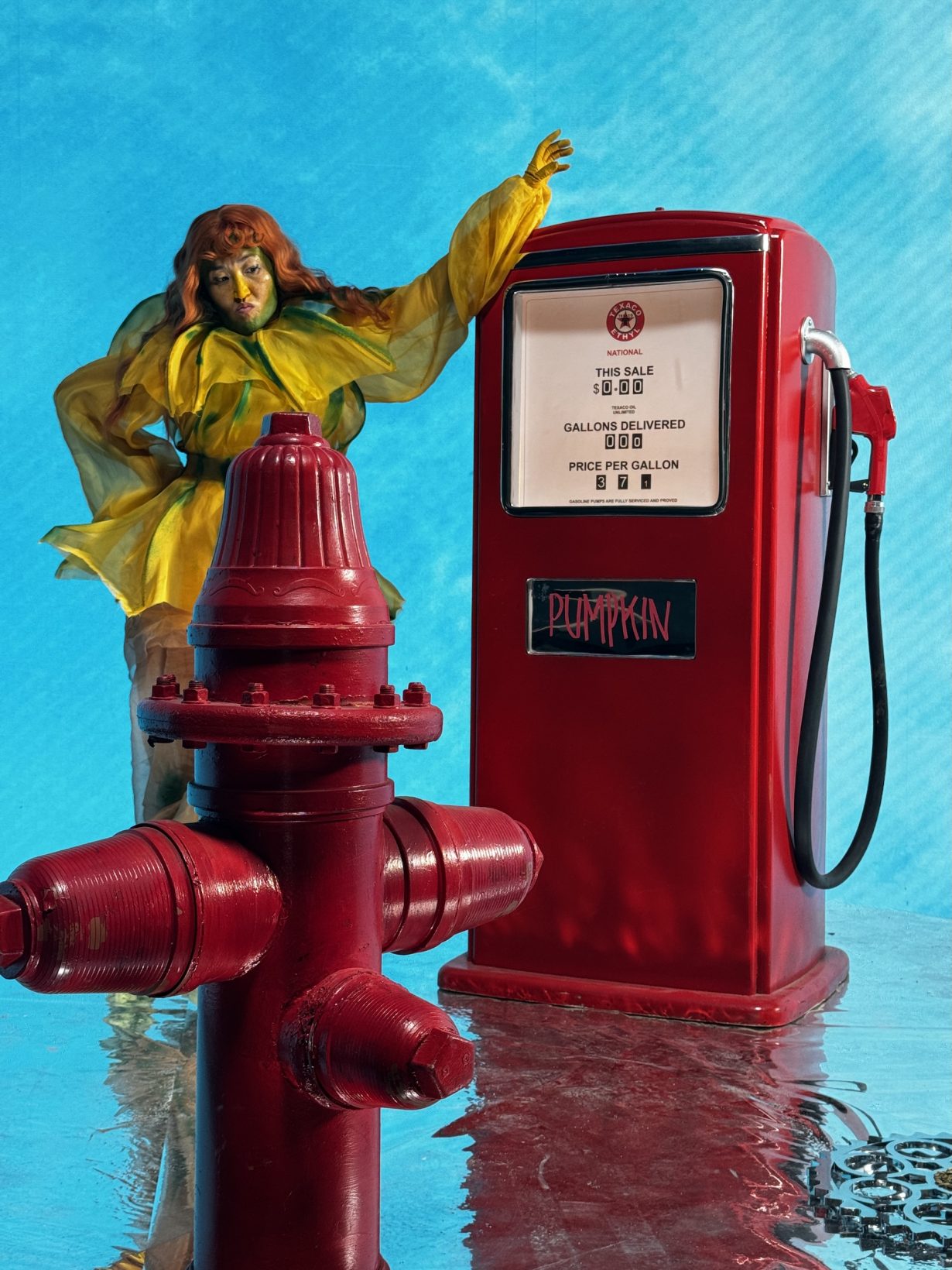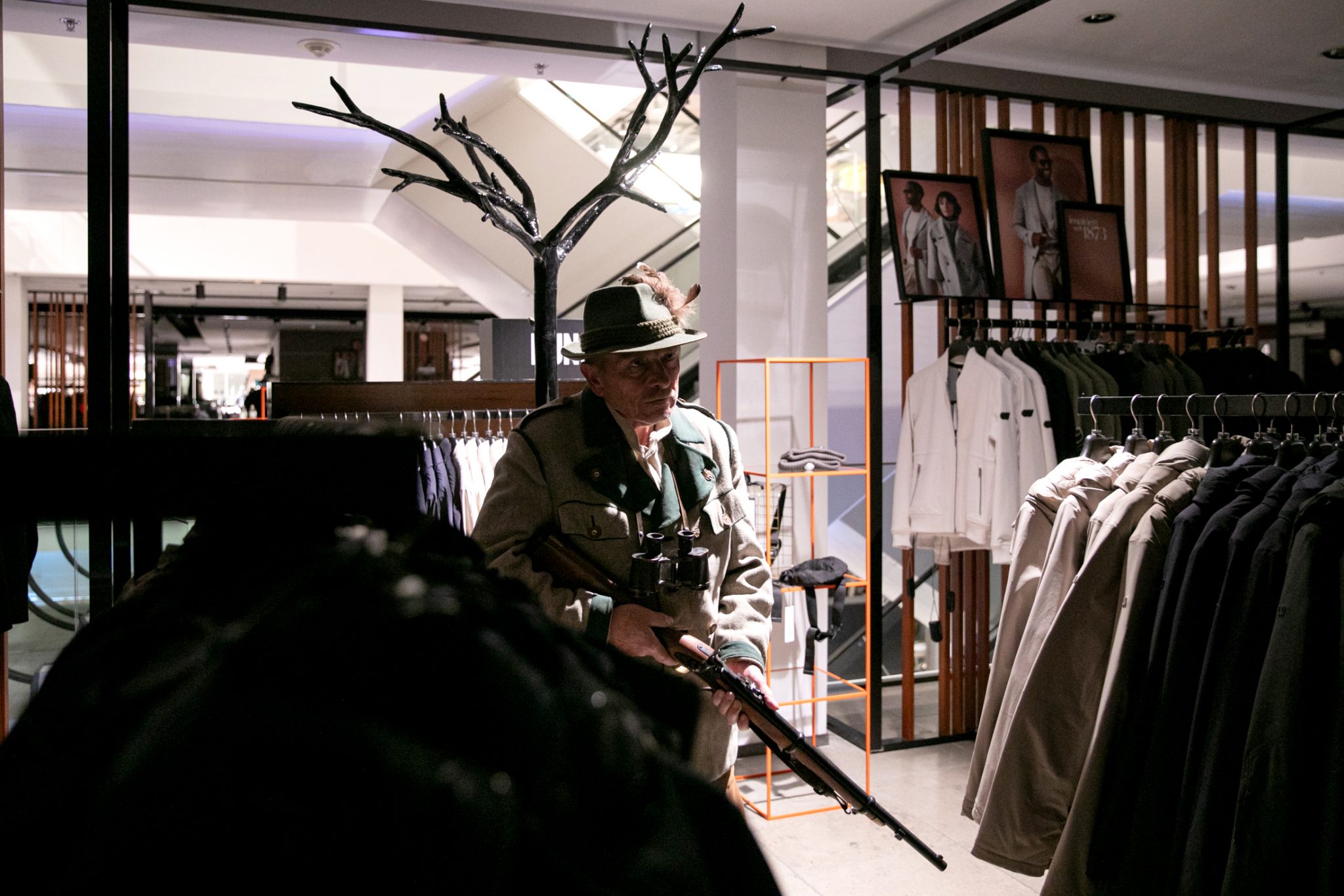It’s time for largescale exhibitions to address the realities of general audiences, rather than catering to the interests of the curatorial class
Peering down from the womenswear floor into the atrium of the opulent Graz department store Kastner & Öhler, our tour group sees, in the basement, glimpsed between the escalators, a hardy woodcutter, in stout boots and waistcoat, chopping logs. His axe rings out from the depths, while mountain birdsong and the sound of running streams tinkle via the in-store PA. As we climb each floor, in the menswear, two older men in traditional Styrian hunting garb, rifles poised, are stalking cautiously through the stacked accessories. As we are ushered past them by our guide, a fresh-faced young woman in a feathered hat, with knapsack and hiking gear strides by, on her way to the lederhosen section ahead.
This satirical vision of a bucolic, traditionalist Austria, spliced into contemporary Austria’s wealthy (but anxious) present, was Thomas Verstraeten’s performance Wanderlust Warenhaus (2024). It was emblematic of this year’s edition of Steirischer Herbst, Graz’s long-running annual arts festival, this year ominously titled Horror Patriae. Conflating the Latin for ‘homeland’ with ‘horror vacui’ – ‘fear of emptiness’ – the festival, centred on a major exhibition at the Neue Galerie Graz, sought to examine the ‘darker side of patriotism’, and, as chief curator Ekaterina Degot declares in her curatorial introduction, ‘to expose the constructed, artificial character of any national identity’. With this edition, Degot writes, ‘steirischer herbst turns against the normalized mild xenophobia celebrated in the form of roots and traditions,’ while asserting that ‘migration, exile, displacement, dissidence and nonbelonging are cornerstones of human society.’
Degot’s formula for the festival (it started in 1968, she took over in 2018) has been notable for its political responsiveness to current events, chafing against the rise of nationalism in Europe and beyond. (Her first edition was provocatively titled Volksfronten, while in the wake of the Russian invasion of Ukraine, the 2022 took A War in the Distance as its theme.) It’s an approach that doesn’t shy away from using the art exhibition as polemical tool. Horror Patriae’s autumn timing meant that it opened ten days before Austria’s legislative elections, in which the rightwing populist Freedom Party of Austria (FPÖ), got the most votes. A party founded in the 1950s by former Nazis, in 2024 the FPÖ has been campaigning for curbs on immigration and asylum seekers, as well as pledging to cut taxes on small businesses and scrap environmental levies. Its manifesto was titled Fortress Austria: Fortress of Freedom.
So, Horror Patriae was a conscious rebuff to another rightward shift in Austrian politics, but rather than a direct address to contemporary populism, its curatorial approach sought to analyse and dismantle what it saw as the historical roots of a politics often couched in ideas of cultural identity. Historical works that embodied Austrian culture’s nineteenth- and early-twentieth-century fascination with folk culture, the notion of ‘Heimat’ and ideologies of a ‘greater German’ culture, found themselves alongside contemporary works that continually probed the construction of national and nationalist identity. Austrian and Styrian identity, it suggested, was always an evolving creation subject to the political demands of each historical moment: from the grandiose epoch of nineteenth-century nation-building and the end of Austro-Hungarian Empire through to the volkish alignment with Nazi ideas of Germanic culture and the tainted retention of prewar folkloric ideals in the postwar period.

That national identities might be ‘confected’ was made literal in Pablo Bronstein’s fantastical confectionary architectural model, a gallery-filling, fantasy museum of disparate historical architectural styles – neoclassical, German Baroque and twenty-first century high-tech. For many of the contemporary works here, the very notion of identity was suspect, an issue entertainingly distilled in Jakub Jansa’s zany video Pumpkinville (2024), depicting a bizarrely synthetic world inhabited by vegetable-based humanoids and its protagonist Celeriac, a sort of root-vegetable private detective. Celeriac’s investigations satirise contemporary culture’s demand for authentic experience, where individualism and wellness culture intersect with reality TV and atavistic ideas of cultural roots. As Celeriac tails the naïve reality-show celebrity Pumpkin (pumpkins are a big deal in Styria), he concludes that desires for authentic identity are merely the delusion of a commodified culture, nothing more than a vast manipulation by the shadowy forces of globalism and neoliberalism.
But although there’s a truth to the argument that national identities are never really the eternal embodiments of an unchanging and rooted ‘people’, Horror Patriae struggled to get beyond the dismissive idea that all national identities are in some way fictive, lacking the authenticity claimed by their adherents. It’s easy to dismiss cultural and national identities as a delusion, but deconstructing the idea of identity as such, into a state of endless hybridity, difference and nonbelonging doesn’t replace it with anything more secure.

Such deconstructive views of identity tend to miss the point of how recent identitarian politics aren’t simply backward-looking, poignantly evoked in Assaf Gruber’s subtle and moving film Miraculous Accident (2024), a semifictional story about a Moroccan student, Nadir, who attends a film academy in 1960s Communist Poland and is taught by – and becomes the lover of – a Jewish film professor, Edyta. Switching between past and present, it follows their subsequent separate lives, post-1968, in lonely, disconsolate exile. Here, belonging isn’t a fiction, but something lost, yearned for – and irretrievable.
As I walked to Kastner & Öhler – a store founded by Austrian Jews in 1873 and whose descendants fled the Nazis in 1939, following the Nazi annexation of Austria the year before – Graz’s main square was taken up by a large pro-Palestine protest. Identities may be constructed, but they are latched to political realities. In Austria and elsewhere in Europe, voters are siding with parties that have sensed their anxieties about the gradual disintegration of their communities, jobs, public services and economies, while established political parties, often of the centre and left, seem unable or unwilling to do anything about it. As a consequence, secure ideas of collective ‘identity’ are coming apart, while the backlash is often felt by immigrant communities.
On this, however, Horror Patriae had little to say, preferring to cling to a sort of abstract morality tale in which everything national, local and rooted is bad – poking fun at the supposed backwardness and absurdity of Styrian traditionalism – while everything hybrid, migratory and ‘nonbelonging’ was good. Discovering in current political frustrations only the zombielike revival of earlier histories of nationalist sentiment may make sense from the point of view of the increasingly internationalised and cosmopolitan culture of curators and artists. But attacking the cultural symptoms of what are more profound social and economic dislocations does little to make sense of the political realities of people – whether they are arriving migrants or people living in the countries of their birth. That kind of art has little to say to other people who, whether they’ve been here for generations, or just arrived, might still need to work out how to live together, and figure out whether living in common together – in something that might be a ‘homeland’ – can ever be possible.
